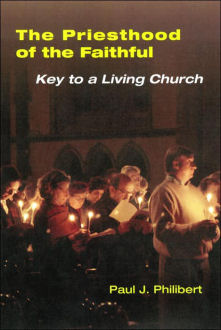
|
Posted October 3, 2005
Book: The Priesthood of the Faithful: Key to a Living Church Author: Paul Philibert Liturgical Press, Collegeville, MN, pp.173 An Excerpt from the Jacket:
An Excerpt from the Book: Obedience is the vow that many religious themselves find the most difficult to understand and to live. The submission of one person’s will to another can appear a moral self-mutilation in a society in which so much passion is expended in seeking power over others. The consumer culture demeans filial relationships, as is evident in the ways in which TV caricatures the lost authority of parents in sit-com families. The idea that someone through loving service might become a sacrament of fatherly or motherly care for a spiritual family has all but disappeared from our lexicon of explanations for obedience. Much of great value has been written in recent years on the meaning of religious obedience. I will only mention two points here. First, religious obedience is a communal virtue. The whole community has pledged itself to listen to the proclaimed word of God and to obey. By listening together — and listening to one another listen, as religious do in chapter, for example, – we move closer to one another as pilgrims on a common journey toward the promise proclaimed to us in God’s word. Without this context of a faithful community, submission of members to a leader loses its theological significance. Second, when religious obedience is indeed rooted in a community alive in God’s word, the willing response to a call to mission and service from a religious superior and frm the community is a true living sacrament of Christ’s own obedience. Obedience that is free, joyful, and creative – that calls persons out of themselves into risks that become fruitful for corporate life, that pushes individuals into new episodes of generosity and generativity – that kind of obedience is really a sign of the kingdom of God. It can only arise out of the following of Christ. And now I must say something that pertains to the explanation of all three vows. The kind of self-emptying, love, and generativity that I have been describing are not charisms reserved in the church for religious alone. Indeed, this is the point. Religious, in undertaking a life that shapes and structures the way they live in order to offer models and incentives to the faithful, find profound meaning not only in their own continuing configuration to their Master, but in their generous commitment to this form of life precisely because it is illustrative and generative for the church as a whole. From this comes the importance of the spiritual hospitality of religious who open up their environments of reflective beauty and their times of common prayer to the faithful. Many of the faithful want to share life with religious and learn from them the spirit of Christ’s poverty, chastity, and obedience as it is lived in the tradition of their institutes. Congar’s insight was that religious are bound to find this understanding of their ecclesial lives more meaningful than a purely juridical interpretation of their vows. Religious who understand that their life is plunged deeply into the mystery of Christ’s priesthood become a source of joy and a call to growth for others. Their life is always fruitful. It is a path of discipleship that leads religious into a personal configuration to their Master. But this same path also opens opportunities for others to recognize and realize the meaning of the Gospel that the church proclaims. It provides comaradeship for those who are fearful or unsure. This theme deserves a fuller treatment than would be appropriate here. But I want to suggest to religious another way to read what we have don in this book. It is an invitation to them to see the very purpose of their ecclesial vocation in light of the fundamental mystery of their baptismal integration into the priesthood of Christ. Table of Contents: 1. A timely discussion 2. Chosen to live 3. Living, holy signs 4. A priesthood embracing Christ’s body 5. People who speak for the Spirit 6. Hearts set on the Kingdom of God 7. Lives lifted in praise 8. An intentional symbolic life |
|
